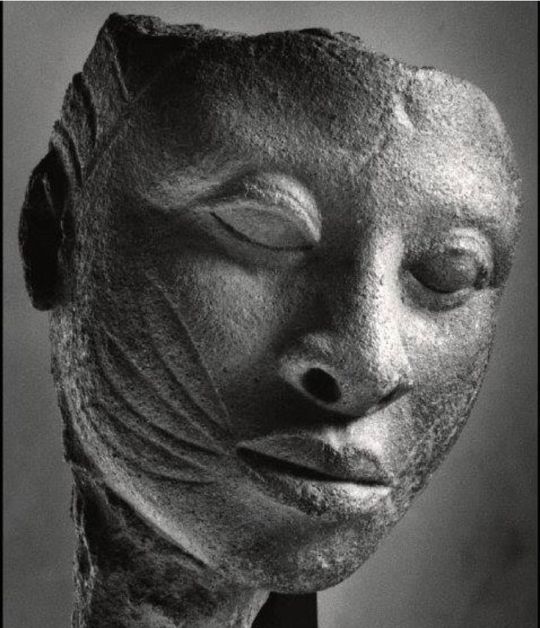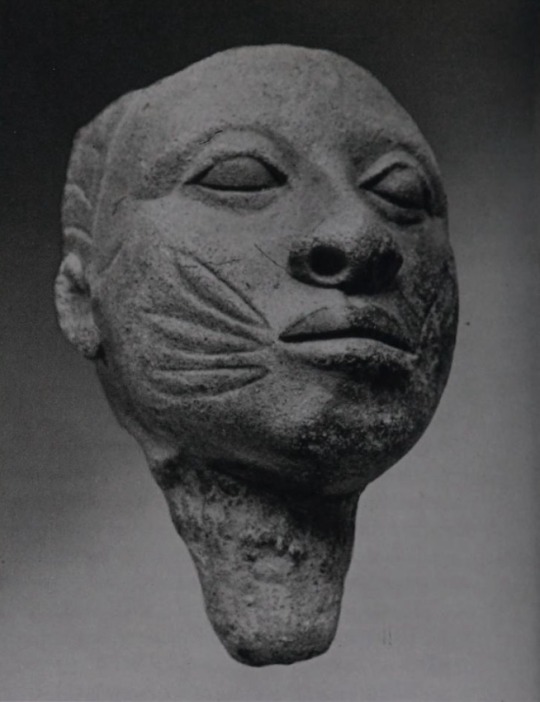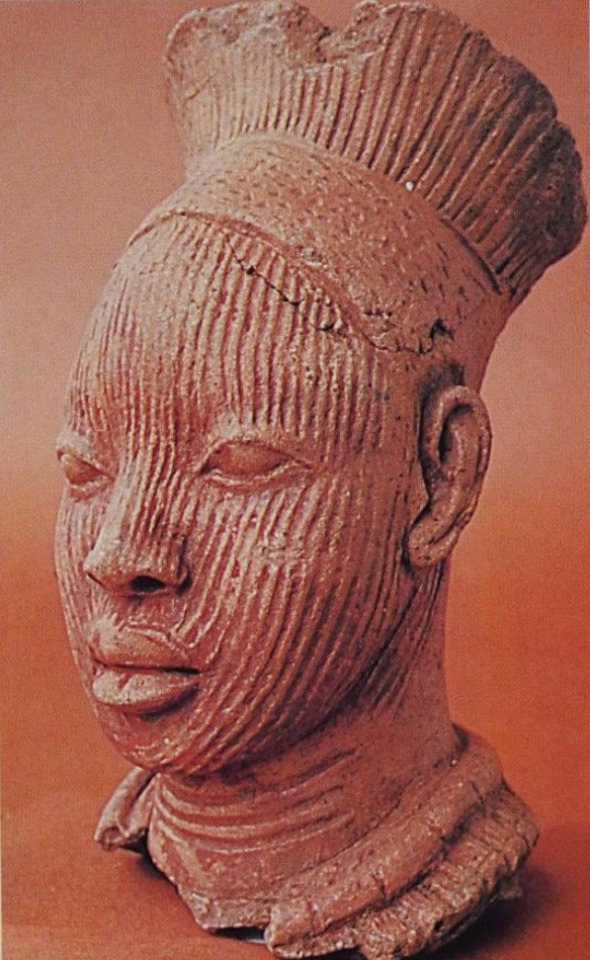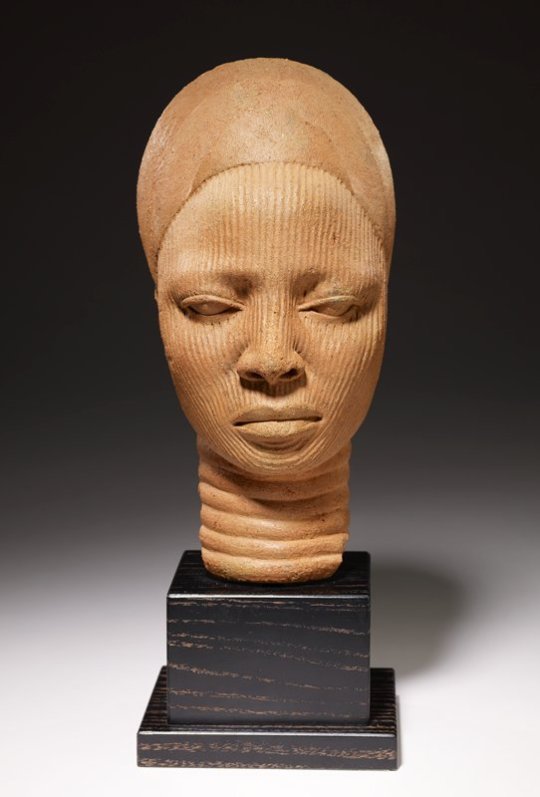#ife terracotta
Text

Unknown, Ifé terracotta, Nigeria, 1200-1400
936 notes
·
View notes
Text
Exploring Ife Terracotta: A Glimpse into Diverse Ancient Artifacts
The Ifé terracotta works from 1000–1400 A.D. are truly a treasure trove of artistic expression. This diverse collection encompasses a stunning array of sculptures and vessels, each depicting a rich tapestry of human, animal, and otherworldly subjects. From larger-than-life full-length figures to diminutive six-inch figurines, the sheer variety in size is awe-inspiring. What’s equally captivating…

View On WordPress
#African Art#African artifact#African History#Art#Artifacts#artist#Ife Terracotta#West African#West African history
0 notes
Photo

MWW Artwork of the Day (8/6/22)
Ife Culture (SW Nigeria)
Head (possibly a King)(c. 12th–14th c.)
Terracotta w/ residue of red pigment & traces of mica, 26.7 x 14.5 18.7 cm.
Kimbell Art Museum, Fort Worth TX
The art of Ife, which flourished from the twelfth to the fifteenth century in southwestern Nigeria, in the area occupied by the Yoruba people, is unique in Africa in representing human beings with extraordinary naturalism. The subject matter of most Ife art is centered around royal figures and their attendants, reflecting the political structure of a city-state ruled over by a divine king, the Oni of Ife. The physiognomy of this head has been modeled with extraordinary subtlety, and the striations, which may represent scarification patterns, are incised with great delicacy. The square crown, formed of four rectangular aprons overlying a conical form and embellished with a network of intersecting beads, is unparalleled in any other known examples of Ife art. The serene and dignified countenance, as well as the elaborate crown, suggests that this head represents an Ife king (Oni).
48 notes
·
View notes
Text

“Head with "cat whisker" marks
Olokun Walode site, lle-Ife, Nigeria, c. early 14th century ce Terracotta; Height: 127 mm
Nigeria National Museums”
163 notes
·
View notes
Photo

Ife Head. Ethnographic Museum, Berlin. Read more about Ife Terracotta here
http-//www.metmuseum.org/toah/hd/ifet/hd_ifet.jpeg
16 notes
·
View notes
Text
Ile Ife, Nigeria (ca. 500 B.C.E.- ) •



Ife is world famous for its art. Between 700 and 900 A.D. the city began to develop as a major artistic center. By the 12th Century Ife artists were creating bronze, stone, and terracotta sculptures, some of which are found today in museums in Nigeria, Europe, and North America. The artistic production of Ife began to wane in the 1500s as political power and wealth shifted to neighboring kingdoms such as Benin and Oyo.
4 notes
·
View notes
Text
the night air is cool against the drow's cheeks - a welcome darkness that holds and comforts her as she steps soundlessly across terracotta tiles. the city slumbers, still for once - a crawling expanse that was ripe for the taking. though her blood had sang in all the battles they had won together, the fight ahead is murkier - a fear that grips her, and paralyzes her. orin will not rest until they are broken entirely, until her knives can find their way home back into sinews and bones. minthara baenre, wayward daughter, will not rest until the changeling dies at her hand - screaming as she had once.
" restless night, d'anthe? you woke me when you left. i had decided to wait for your return, but the time grew longer than i was willing to allow. " i am worried for you. it hangs unsaid in the air as she stares resolutely into the night sky; dark and vast and infinite enough to sink into, and she allows the silence to sit between them - comforting, if not heavy. no doubt the past few weeks has weighed heavily upon @folie2deux ; the night warden can feel it pressing down upon everyone in the party - one weakness, and it will crush them.
it is not the urge, whatever madness that is, that haunts elys these nights - not weakness, either. she speaks of doubts and worries; and minthara understands, she does - but the night warden had been made to fight, not feel as keenly as she wishes to - it is a soldier's duty to push such thoughts aside, and carry on. elys cannot be afforded the luxury of such thoughts now; not after everything, not after all the blood that had been spilt - that would still flow. still, she sits down - dangling her legs over the edge of the gutter, a soft breath leaving her as she does so.
" you have shown yourself to be both capable and intelligent. do not sully yourself by indulging in such doubts. " as if the night warden was not paralysed by her own - the fears and uncertainties, the what ifs that shadowed her. it is a strange kinship - minthara's memories were intact just as elys' were shattered, but the damage remained the same - they did not know themselves; only what they were capable of. it brings a strange sort of comfort to the night warden; one she both covets and hides from; the shame of leaning on another - of needing someone. all those knives chasing her in the dark, even here; her paranoias and fears confirmed, made new. it is a weakness, it is - but it does not have to be.
briefly, her red, red eyes flick to elys - take in the curve of her nose, the line of her jaw. the night warden clears her throat, and looks to the stars. " do you not already know who you are through your deeds? such acts - be they good or ill, tell more about a person than any memory. " and elys is as glorious upon the battlefield as she is now; bathed in the silvery light of the stars - doubts and all. " you certainly do not need any god, much less bhaal, to tell you who you are. should he try and tug upon your leash, we will rip him from his throne and drown him within the blood he so desperately demands. " the chuckle that leaves her is throaty; rough voice warm with pleasure, her smile curved like her blade - sharp, and just as dangerous.
" there are no stars in the underdark. when i was young, i was enthralled by the changing of the guard at house baenre - to see our finest soldiers and warriors take their posts in a blaze of light and colour. visitors would pay our matron mother a tithe to see it - were i able to see my home again, it would be one of the first wonders i would show you. " trust is a hard won thing; the night warden's heart is guarded, for good reason. her entire body seems to relax; aches and pains she'd ignored now felt all too keenly, the weight of it all upon her. so close, yet still so far from the end - oh, how sweet it would be to hear the changeling scream for once - how exquisite it would be to take her head and present it to elys on a platter. these thoughts, for once, minthara does not voice - instead offering another, smaller piece of herself in the darkness.
" the stars were the first thing i saw above that did not blind me. perhaps it is proof that not everything in your lands is tainted by the blighted sun. "
from here.
#oop this got long (written in my notes app)#folie2deux#ACT II. soon there will be vengeance. then; freedom.#gay.
1 note
·
View note
Text
0 notes
Photo

Terracotta head from the Ife civilization. Learn about the beauty of African cultures, including the Yoruba and Voodoo religions, in my new book!
https://www.amazon.com/dp/B07MD4HCSK?ref_=pe_3052080_276849420
#ife#ile ife#black art#black history#africa#nigeria#benin#yoruba#voodoo#terracotta#art#woman#head#martin luther king#mlkday#mlkjr#new books#writing#artists on tumblr#gods of the flesh#blackgirlmagic#kindle#ebooks
13 notes
·
View notes
Photo

The Beginnings of the Yoruba
So monumental was the role of Ooni (King) Oduduwa of the Ife Kingdom that popular traditions and legends elevated him to the pedestal as the father of the Yoruba people, all people of the world, and he was crowned as the first person to walk the earth.
To find out more about the Great Ife Kingdom and King Oduduwa of West Africa, Click here: https://bit.ly/3wRTbYi
0 notes
Photo

MWW Artwork of the Day (6/16/18)
Ife culture (Nigeria)
Male Head (12th-14th c.)
Terracotta bust, 15.5 cm. high
Musée du Louvre, Paris
Ife is an ancient Yoruba city in south-western Nigeria. Evidence of habitation at the site has been discovered to date back to as early as 600 BCE. Important people were often depicted with large heads because the artists believed that the Ase was held in the head, the Ase being the inner power and energy of a person. Their rulers were also often depicted with their mouths covered so that the power of their speech would not be too great. They did not idealize individual people, but they tended rather to idealize the office of the king.
The city was a settlement of substantial size between the 9th and 12th centuries, with houses featuring potsherd pavements. Ilé-Ifè is known worldwide for its ancient and naturalistic bronze, stone and terracotta sculptures, which reached their peak of artistic expression between 1200 and 1400 CE. After this period, production declined as political and economic power shifted to the nearby kingdom of Benin which, like the Yoruba kingdom of Oyo, developed into a major empire.
Bronze and terracotta art created by this civilization are significant examples of realism in pre-colonial African art. The model here was probably one of the king's servants. (Wikipedia extracts)
56 notes
·
View notes
Text

“Ife, Nigeria, terracotta, height 8" (20 cm).”
Elisofon Archives, Museum of African Art, Washington, D.C.
Photo: Eliot Elisofon.
From: “Images in clay sculpture : historical and contemporary techniques” by Speight, Charlotte F., 1983.
44 notes
·
View notes
Photo

Nigeria recovers stolen 600-year-old Ife Terracotta
https://nigerianeyez.blogspot.com/2020/11/nigeria-recovers-stolen-600-year-old.html
0 notes
Photo

Shrine head, 12th-14th century, Minneapolis Institute of Art: Art of Africa and the Americas
This head’s tranquil demeanor and introspective gaze express what the Yoruba peoples consider a person’s inner virtue. It is a memorial portrait head that comes from the royal city of Ife in western Nigeria, a center of economic, religious, and political power between 1100 and 1400. Ancient Yoruba artists made heads in bronze and terracotta that were part of complete figures or, like here, freestanding. The vertical lines covering the woman’s face either reflect the traditional scarification designs used in the Ife kingdom or represent the veil worn by members of the royal family.
Size: 12 1/4 x 5 3/4 x 7 1/4 in. (31.1 x 14.6 x 18.4 cm)
Medium: Terracotta
https://collections.artsmia.org/art/4866/
257 notes
·
View notes
Photo

Nigeria: Terracotta head excavated from the former grove of Olokun Walode at Ife. From "Africa: history of a continent" by Basil Davidson, 1972. https://www.instagram.com/p/CWOhLZntPlX/?utm_medium=tumblr
171 notes
·
View notes